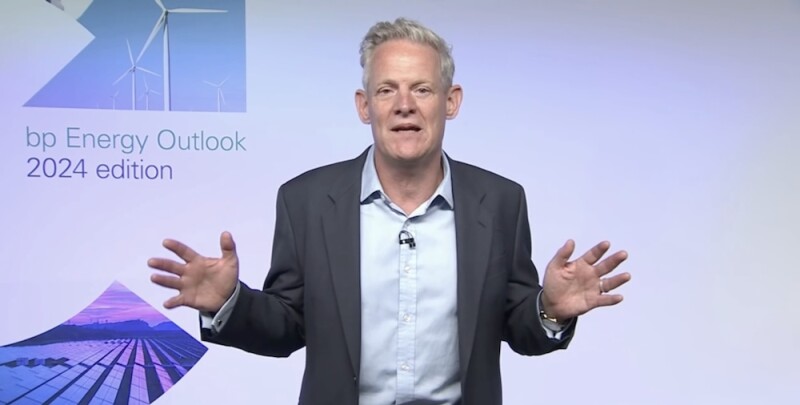The energy system’s big decarbonization challenge over the next quarter century is a timely move from an energy addition environment to one of energy substitution.
In presenting the BP Energy Outlook, 2024 edition via webcast on 10 July, Spencer Dale, BP’s chief economist, said the longer it takes for the world to begin substituting fossil fuels to reduce carbon emissions, the more likely the transition will be costly and disorderly.
“The one thing we know for sure is that over the next 25 years, the energy system will change in ways that we can't even imagine today,” he said.
He said the current version of energy security highlights the dangers associated with globally integrated energy markets and dependence on imports, particularly against the backdrop of the ongoing Ukraine war. Now energy security stresses the benefits of domestically produced energy, or obtaining energy from resilient, trusted, and diversified resources, he added.
“I know the concept of the energy trilemma—the importance of energy systems providing energy which is secure and affordable, as well as sustainable--may feel a little stale, a little out of date, but I would argue its relevance has never been greater,” Dale said. “Any successful and enduring transition needs to address all three elements of the trilemma.”
BP’s 2024 edition of the outlook explores the speed and shape of the energy transition out to 2050 using two carbon emissions scenarios.
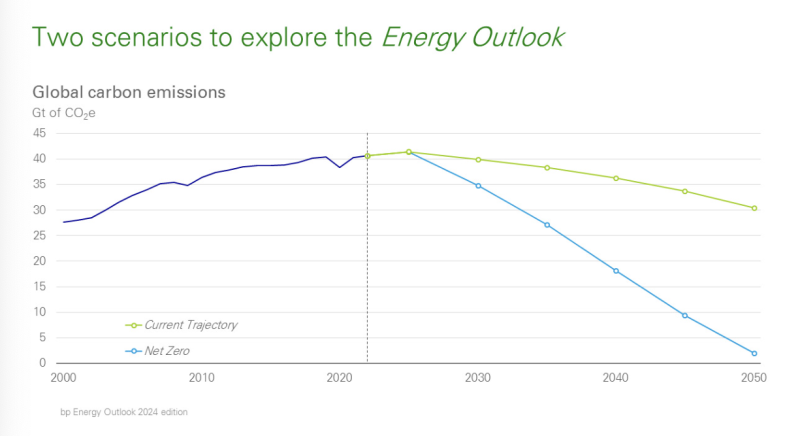
The current trajectory scenario reflects climate policies already in place, pledges to decarbonize, and the difficulty of meeting those pledges, which drops emissions from their current level by about 20% by 2050. This pathway, if continued, is not consistent with a 2°C carbon budget, he said, and the longer the world remains on that path, the harder it will become to achieve that target.
The net-zero scenario, what Dale called a “what if” scenario more consistent with achieving Paris climate goals, explores how the energy system might change if the world collectively acts to reduce carbon emissions by about 95% by 2050. The scenario assumes a significant tightening in climate policies, shifts in societal behavior and preferences, gains in energy efficiency, and the widespread adoption of low-carbon energy.
“Both of these scenarios will be wrong. We can't predict the future. We know we can't predict the future. Rather, the two scenarios simply provide a rough sense of how the global energy system might evolve under different assumptions about the future,” Dale said. “Taken together, current trajectory and net zero span a wide range of the possible outcomes facing the global energy system, and as such, they can help inform a strategy which is resilient to a wide range of the uncertainty that we face.”
Right Now, It’s Energy Addition
While low-carbon energy has increased, its contribution to the energy mix isn’t enough to keep pace with overall energy demand growth, he said.
“As a result, the consumption of unabated fossil fuel use without capturing and storing their emissions is continuing to increase alongside the growth in low-carbon energy,” he said. “The world is in what might be called an energy addition phase of the energy transition, in which both types of energy–old and new, unabated fossil fuels and low-carbon energy–are both growing.”
Energy addition phases are nothing new. In the mid 19th century, coal grew rapidly and supplanted wood and other primary energy sources, followed about a century later by the rapid growth of oil, which overtook coal as a dominant energy form.
In both examples, the world continued consuming similar or growing amounts of the old energy even as it adopted the new energy form, he said.
“The world has never reduced its consumption of any fuel on a sustained basis. It's just consumed more of everything,” Dale said, calling that the historic challenge facing the global energy system. If the world wants to decrease carbon emissions, “it can't remain in the energy addition phase indefinitely.”
Instead, the energy system needs to move from energy addition to energy substitution, with the growth of new, low-carbon energy exceeding the increase in total energy demand, which will cause the consumption of old energy, or unabated fossil fuels, to decline, he said.
And while both the current trajectory and net-zero paths see a shift from addition to substitution occurring, the chief difference is in the timing and intensity.

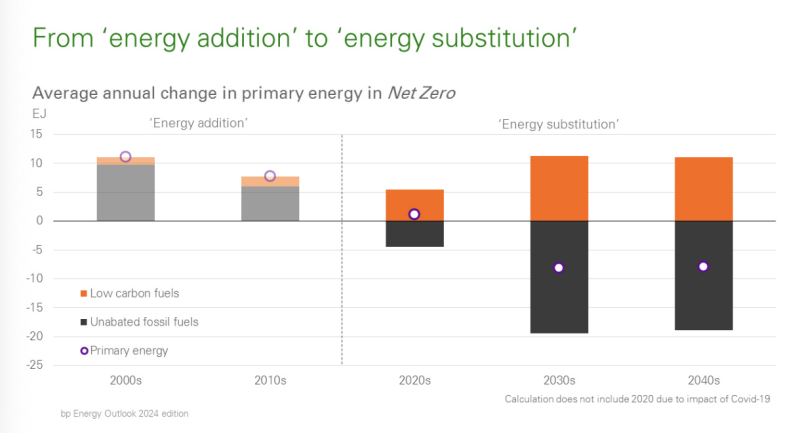
“In the current trajectory, the energy addition phase continues in the 2020s,” with fossil fuels still accounting for two-thirds of primary energy in 2050, compared to its current contribution of a little over 80%, he said.
On the net-zero pathway, low-carbon energy substitution for fossil fuels begins in the 2020s and gathers steam through the 2030s and 2040s, he said, so by 2050, the share of unabated fossil fuels in primary energy declines to about 20%. Achieving that requires a sharper acceleration in energy efficiency, an even faster growth in low-carbon energy, and a reduction in the world's overall energy needs, Dale said.
Oil Drops. Natural Gas In?
Oil demand drops in both scenarios, although it plays a larger role in the current trajectory scenario. In that case, oil demand is around 80 to 100 million B/D through 2035, falling to around 75 million B/D by 2050. In the net-zero scenario, that drop is far quicker, falling to 25 to 30 million B/D, or about 70% of current demand, by 2050, he said.
“The single biggest cause of this decline in oil demand is the falling use of inroad transport” through improved efficiency of the global vehicle fleet and increasing electrification of cars and trucks, Dale said.
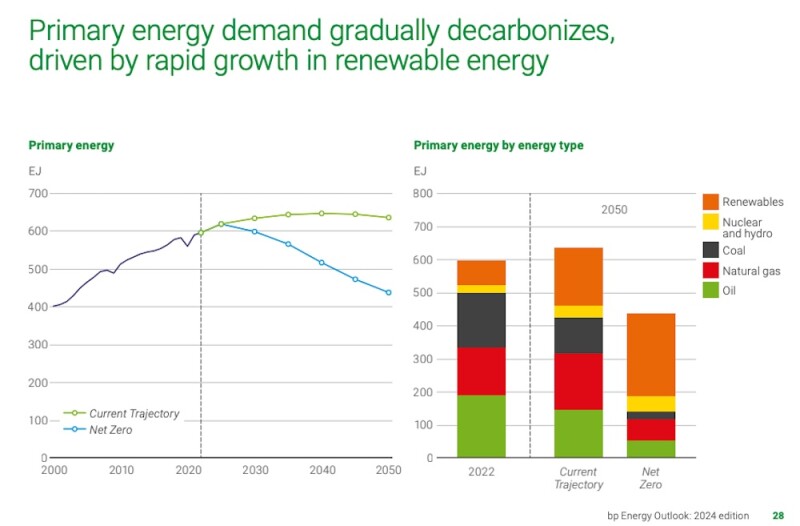
On the other hand, in the current trajectory scenario, natural gas increases by 20% over current levels by 2050, he said. In the net-zero scenario, natural gas initially increases before falling to about half of its current level by 2050.
“The dominant factor in the current trajectory is increasing use of gas in emerging economies as they grow and industrialize. In contrast, in net zero, natural gas demand is crowded out as energy systems around the world increasingly electrify and the share of wind and solar in power generation increases,” he said.
Much of the growth in natural gas demand in emerging economies is being met by liquefied natural gas (LNG).
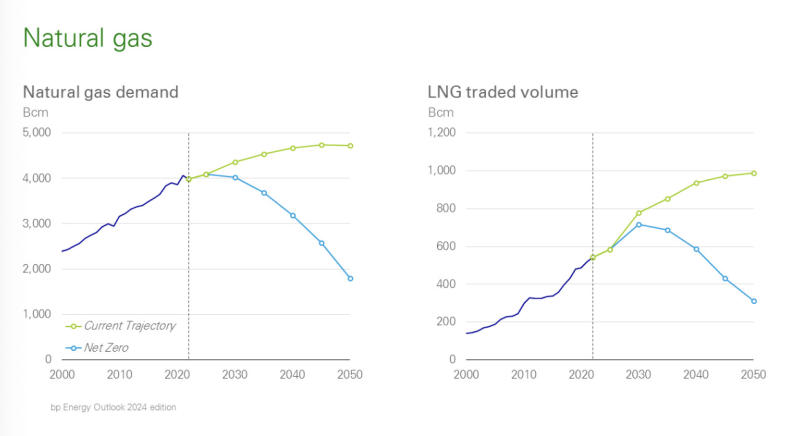
“It follows that this uncertainty concerning the future level of natural gas demand is also reflected in uncertainty about the level of LNG trade,” which increases by 80% in the current trajectory scenario but falls by about 40% in the net-zero scenario, he said. That range of possible outcomes adds to the uncertainty associated with investing in energy facilities, he added.
Electrifying Performance
The world has seen a rapid growth in wind- and solar-powered electricity, with much of that in emerging economies where increased access to electricity is improving living standards, he said.
“Today, just over a little over 20% of the world's final energy demand is electrified,” he said.
In the current trajectory scenario, that increases to about a third by 2050, and in the net-zero scenario to more than half by 2050.

Electricity’s increasing role is reflected around the world for industry, transport, and buildings.
“More and more of our everyday processes and activities are electrifying,” Dale said.
The growth of wind and solar power is driving the increase in low-carbon energy and the move to energy substitution in both scenarios, he said, noting the surge in wind and solar power particularly for the first 10 to 15 years is underpinned by continuing cost reductions.
“Although necessary, these cost reductions are not sufficient on their own. The rapid expansion of renewable power requires wind and solar capacity to be deployed more quickly than ever before,” he said.
That requires a number of enabling factors, including grid infrastructure, planning, permitting, social acceptability, and scale, he said.
Implications of Delay
“The longer the world remains on something like the current trajectory, with this very slow and shallow pace of decarbonization, the harder and potentially more costly it will be if governments and society at some point decide to take the actions necessary to meet the Paris climate goals,” Dale said, naming that scenario “delayed and disorderly.”

A delayed and disorderly scenario is based on the energy system continuing along the current trajectory until sufficient policies and actions begin to accelerate carbon-emission reduction. It is also based on the assumption that there is a limit to how quickly the world can decarbonize the global energy system in an orderly manner without having to resort to policies and actions that have “outsized economic and social costs,” he said.
Dale said if the move to an accelerated transition path is delayed much beyond the early- to mid-2030s, an orderly transition that remains within a 2°C carbon budget is increasingly impossible.
“Costly or disorderly measures would be needed to reduce or curtail the use of other unabated fossil fuels and so achieve an even quicker pace of decarbonization,” he said, calling it sobering arithmetic. “It sort of begs the question of what the world needs to do to shift from the current pathway to something more akin to net zero.”
Accelerating Actions
The single largest element accounting for the faster transition pathway in the net-zero scenario is the quicker, more-comprehensive decarbonization of the global power system. Rapid decarbonization in the industrial, transportation, and buildings sectors would also speed decarbonization toward a net-zero pathway, Dale said.
Growing demand from emerging economies will drive the pace of power sector decarbonization, he said.
“The rapid growth of electricity demand in many emerging economies means it's far harder to grow low-carbon energy sufficiently quickly to both meet the growth in power demand and displace existing fossil fuel” to move from energy addition to energy substitution on the current trajectory, he said. But in a net-zero scenario, wind and solar grow more quickly to help crowd out coal use.
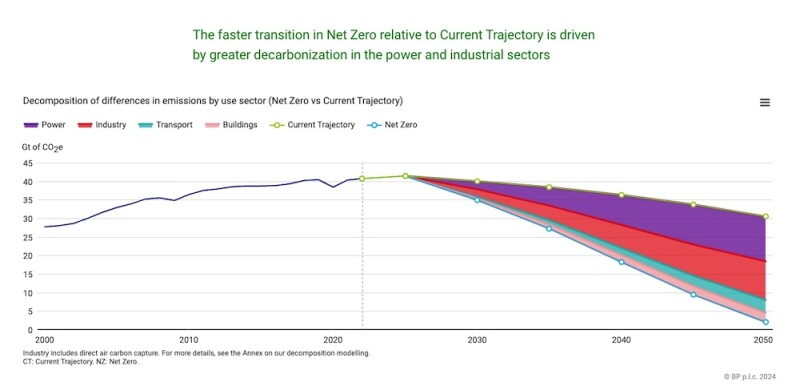
Lower-carbon electricity and efficiency improvements can help industrial processes decarbonize more quickly, he said.
“The industrial sector accounts for more carbon emissions than the other two sectors combined” so faster decarbonization and improved energy efficiency in that sector will have a larger impact,” he said.
Policy incentives and support are needed to drive faster, more-widespread adoption of different low-carbon technologies in different sectors, Dale said. Examples include increased electrification in light industry, greater deployment of carbon capture, use, and storage (CCUS) in the cement sector, and use of low-carbon power and hydrogen in steel.
“All these technologies exist today. The challenge is to apply at speed and scale,” Dale said.
When it comes to transport, increased electrification of cars, particularly in emerging economies, will be a significant driver of speeding decarbonization efforts in that sector, he said.
A Global Effort
Reaching the net-zero pathway requires the whole world to decarbonize, he said.
“It's not enough for the developed world to focus on decarbonizing their own domestic energy systems. They also need to help the world too. They also need to help and support emerging economies to transition.”
Energy efficiency–often overlooked in policy discussions–is important but sometimes “feels like the poor cousin of climate discussions,” he said. “The ability of the world to move quickly from energy addition to energy substitution depends on a significant acceleration in energy efficiency. And energy efficiency is also the best possible response to the energy trilemma.”
It’s important to realize a faster energy transition doesn’t necessarily require lots of inventions, Dale said.
“There will undoubtedly be huge amounts of innovation and technological progress over the next 20 years helping the world to transition, many of which we may not even be able to think of today. But the big differences in net zero relative to current trajectory don't stem from new inventions or technological breakthroughs. Rather, they come from the faster and wider application of known technologies: wind and solar in power markets, electrification, low-carbon, hydrogen, and carbon capture, use, and storage.”

